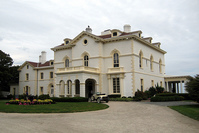We are the… 50%? stories misinterpret median incomes

This is not what we’re talking about. Image by wallyg on Flickr.
The 5-month old news that the Washington region has 10 of the 15 “wealthiest” US counties got another round of press, DCist notes, after a MainStreet.com article subtitled, “Where the 1% lives.” But juxtaposing “the 1%” and any statistic of median income flunks basic statistics.
The median household income is the income for the household which is exactly in the middle: half of the other households make more, half make less. The MainStreet article could far better have borne the title, “Where the 50% lives.”
Median income tells you almost nothing about where the 1% lives. If a town has 10 households making $1 million a year and 100 making $20,000 a year, the median is $20,000. It doesn’t matter if one of the rich 10 starts making $5 million instead.
Medians also don’t consider desperately poor households, unless a place is so poor that half of its households are in poverty. When the news broke that the DC area has the highest median income of any metropolitan area, most of the news coverage about how DC is insulated from the economic downturn ignored that fact that there’s serious unemployment and poverty in much of the region.
The unemployment rate might be lower than the national average, for sure, and far lower than in some parts of the country, but that’s little comfort to the people without jobs.
Much of the disparity goes hand in hand with a higher cost of living. The national median household income in 2010 was $50,046, and the median in the DC region $84,623. But real estate prices are significantly higher here and have been climbing as well. For the 4th quarter of 2011, the median single-family home sales price was $325,400 and the median condo sales price $230,000, according to the National Association of Realtors. Nationally, the average house price was $166,200 and the average condo price $165,100.
Thanks in part to the higher housing costs and limits on the quantity of housing in walkable areas with good transit access, many professionals share housing in the DC region. When Rob lived in a group house in Arlington, the household income was about $160,000. That sounds like a lot on paper, and it’s definitely above the area median, but 3 entry-level professionals and a grad student shared that income, and none considered themselves individually wealthy. On the other hand, a husband/wife household with no kids and a $160,000 combined income might feel a lot wealthier.
If these statistics aren’t about the super-rich 1%, who is the median? To figure this out, Rob analyzed 2007-2009 American Community Survey microdata for people in households making within 5% of the median income (or in the range of $80,538-
$89,014). There are 197,831 people living in such households, which represents a bit less than 4% of the total metro area population.
The average age in this median household income cohort is 43 years. 48% are non-Hispanic white, 26% non-Hispanic black, 13% Hispanic, and 10% non-Hispanic Asian. 21% work for the government, 66% work outside the government, and 13% are not working, out of the labor force or fall into another category. 69% live in owner-occupied homes, while 31% reside in rented homes.
It’s great that the economy in the Washington region is doing well, at least for many people, and that median incomes are high, even if that means housing is expensive too. But reporters, when you write about these income statistics, please leave the references to fancy dinners and pictures of houses with gilded gates out of it.
